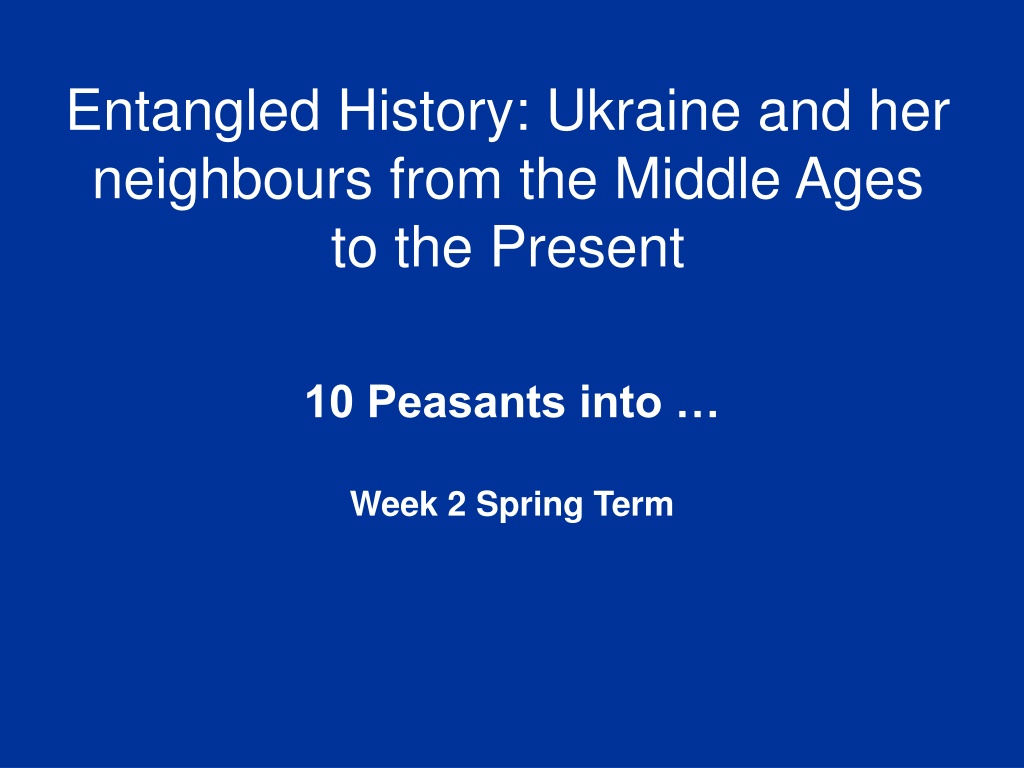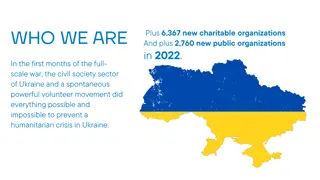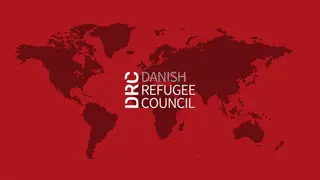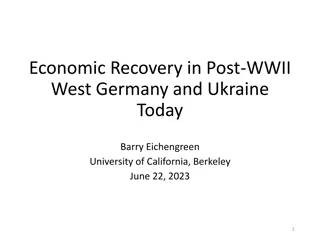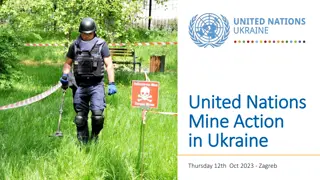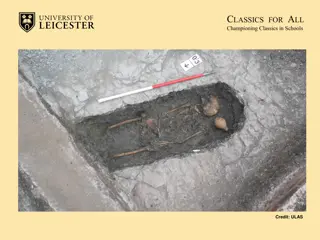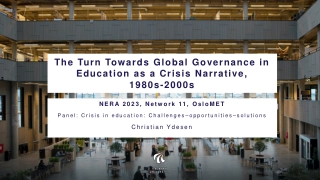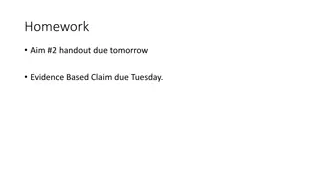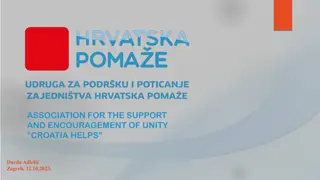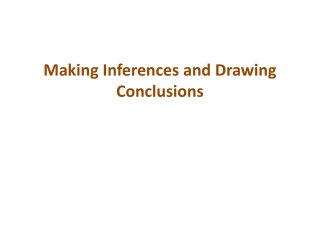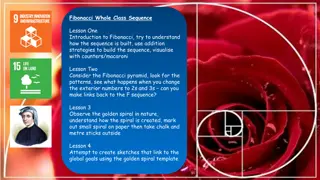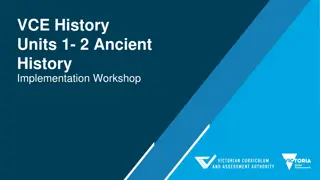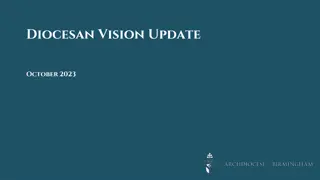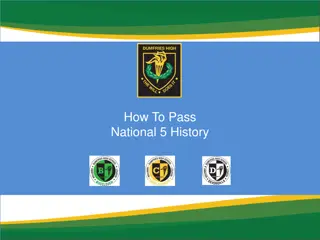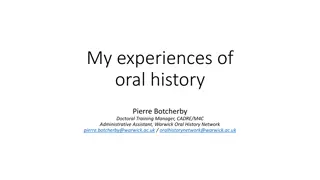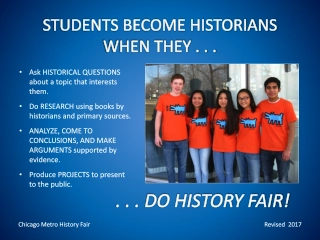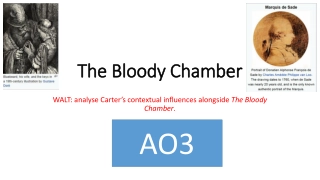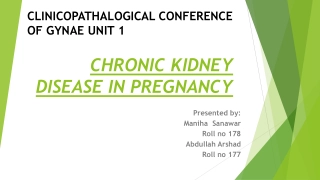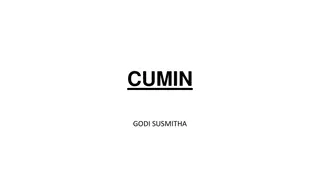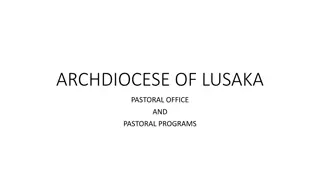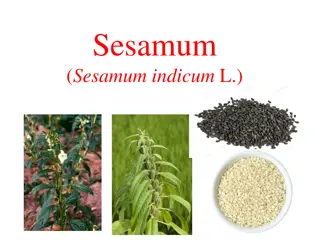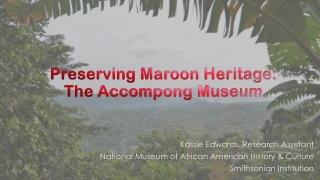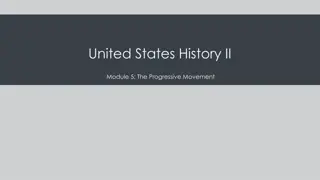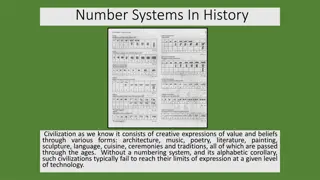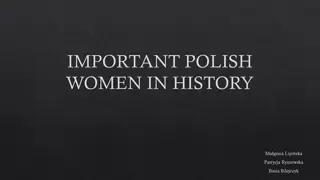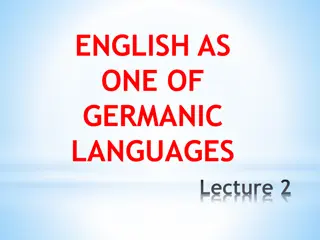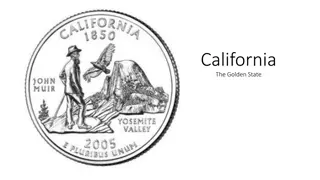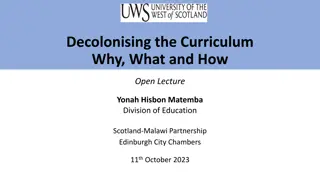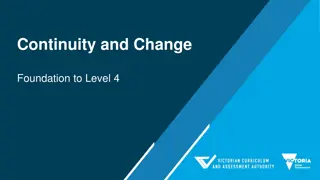Unraveling the Entangled History of Ukraine and Her Neighbors
Explore the intricate history of Ukraine and its neighboring regions from the Middle Ages to the present day, focusing on nation-building phases, interactions with the peasantry, and cultural struggles under various empires. Witness key events like the liberation of peasants, language prohibitions, and the formation of secret societies, shedding light on the complex dynamics shaping Ukraine's identity over centuries.
Download Presentation
Please find below an Image/Link to download the presentation.
The content on the website is provided AS IS for your information and personal use only. It may not be sold, licensed, or shared on other websites without obtaining consent from the author. Download presentation by click this link. If you encounter any issues during the download, it is possible that the publisher has removed the file from their server.
Presentation Transcript
Entangled History: Ukraine and her neighbours from the Middle Ages to the Present 10 Peasants into Week 2 Spring Term
1. Introduction 2. Phase B (Hroch) of Ukrainian Nation Building: 1840 to 1880 3. Reaching out to the peasantry 4. Phase B/C in Austria Hungary: Galicia as Ukrainian and Polish Piedmont 5. Conclusion
Phase A (In white Ukrainophile activities in the Russian Empire, in yellow such activities in the Austrian Empire/ Austria-Hungary, in orange actions of Russian imperial authorities, in red Polish actions 1798 Ivan Kotlyarevsky publishes Eneyida (in the vernacular, i.e. script based on spoken Ukrainian) 1804/5 Foundation of University of Kharkiv in Sloboda Ukraine 1819 Appearance of Natalka Poltavka 1823-1825 Secret Brotherhood of Slavs 1830 November Uprising in Poland 1834 Founding of the University of Kyiv (Russian) 1837 Appearance of Dnister Rusalkas (Ruthenian Triad: Markiian Shashkevych, Yakiv Holovatsky, and Ivan Vahylevych) 1839 Dissolution of Uniate Church in Russian Empire 1840 Taras Shevchenko publishes Kobzar Transition to Phase B 1846/47 Brotherhood of Sts. Cyril-Methodius (Kyiv)
Phase B 1848 Liberation of peasants in Galicia 1848 Supreme Ruthenian Council in Lemberg/Lviv In 1850s first Hromada in St. Petersburg, secret Ukrainian education and culture societies (Hromada) in the Ukrainian provinces of Russian Empire private Sunday Schools in Right-Bank Ukraine (in Ukrainian) 1861 Emancipation of serfs in the Russian Empire 1861 ff: Railways in Ukraine, industrialization of the Donbas, iron ore mining in Kryviy Rih 1863 Polish January Uprising in the Russian Empire 1863 Use of Ukrainian language prohibited by Russian government (Valuev Decree) 1876 in the Ukas of Ems prohibition confirmed
Valuev Circular (1863) Religious and secular writings in Ukrainian are not allowed to be published in the Russian Empire. Kiev Censorship Committee: the Ukrainian language never existed, does not exist, and shall never exist Ems Ukas (1876) The importation into the Russian Empire, without special permission of the Central Censorship over Printing, of all books and pamphlets in the Little Russian dialect, published abroad, is forbidden. The printing and publishing in the Empire of original works and translations in this dialect is forbidden with the exception of (a) historical documents and monuments; (b) works of belles lettres but with the provision that in the documents the orthography of the originals be retained; in works of belles lettres no deviations from the accepted Russian orthography are permitted and permission for their printing may be given only by the Central Censorship over Printing. All theatrical performances and lectures in the Little Russian dialect, as well as the printing of text to musical notes, are forbidden.*
Major Ethnic Groups in the Russian Empire 1897 (125,640,000) Russians Ukrainians Belarusians Poles Jews Other ethnic groups in the West Ethnic groups in the North Ethnic groups Volga/Ural Ethnic groups in Siberia Ethnic groups in the Steppe Ethnic groups in the Transcaucasia Ethnic groups in the Caucasus Ethnic groups in Central Asia Diaspora groups (1.43% Germans) 44.31% 17.81% 4.68% 6.31% 4.03% 4.47% 0.42% 5.85% 0.99% 1.99% 3.53% 1.05% 5.69% 1.91%
1. Introduction 2. Phase B (Hroch) of Ukrainian Nation Building: 1840 to 1880 3. Reaching out to the peasantry 4. Phase B/C in Austria Hungary: East Galicia as Ukrainian and Polish Piedmont 5. Conclusion
Peasants into Task: Make peasants into Russians, Poles, Ukrainians Precondition: End of serfdom. Abolished in Prussia 1807/10, in Austria 1848, in Russia 1861 Problems Liberation without land (peasants have to pay for it): sharp social and economic conflicts between peasants and estate owners persist Gulf between nobility and nationally mobilised urban elite on the one side and peasants on the other side Level of literacy: 1850 in Prussia 85%, 1873 in Austrian Galicia 20%, 1897 in Russian Empire 21.1% Fear of estate owners and conservatives of effect of better education and literacy on peasants Ukrainian nationalism is competing with Russian nationalism and socialism for mass support Russian imperial authorities support in the case of Ukraine Russian nationalists but fight against Ukrainian nationalism, and socialism
Imperial dilemmas (Russian Empire) Dilemma 1: to compete with the other great powers modernisation is needed, for effective modernisation the co-operation and support of the elites and the education of the population is necessary. But end of autocratic rule, sharing of power, education also vehicle for wrong revolutionary ideas elites are scared of peasant uprising enormous gulf between elite and peasants (no matter whether Ukrainian, Russian, or whatever speaking) Dilemma 2: Russification of minorities aimed at transforming Russia into a Russian national space. But Russification could provoke resistance of other ethnic groups
The Ukrainian problem in the Russian Empire For Russian authorities and for Russian nationalists Ukrainian speaking peasants (18% of the population of the Russian Empire) were essentially Russians, sometimes called South Russians or Little Russians. In 1880 almost all of them are Russian-Orthodox, but speak Ukrainian dialects (not Russian) and have customs and traditions different from those of the Great Russians. Russian authorities and nationalists compete with Ukrainophile activists and intellectuals for the souls of these peasants. One can safely assume that most Ukrainian speaking peasants were nationally indifferent but had strong local and regional loyalties.
What is Russification? Three varieties (Thaden) Unplanned: certain individuals take on Russian culture and language, takes several generations Administrative: demand by the Russian government that Russian must be used in administration everywhere in the empire Cultural: active policy that aims to replace a population s native culture with Russian Edward C. Thaden et al., Russification in the Baltic Provinces and Finland, 1855-1914 (Princeton, 1981), pp. 7-8 Theodore R. Weeks, Russification: Word and Practice 1863-1914 , in Proceedings of the American Philosophical Society Vol 148, No. 4, December 2004, pp. 473-474
The Ukrainian question and the Polish question In the Russian Empire, imperial authorities, Russian nationalists, and Ukrainophiles were united in their efforts to reduce Polish influence. The sharp social conflict between Ukrainian peasants and Polish estate owners made any attempts of Polish nationalists to acquire Ukrainian speaking peasants for the Polish nation doomed to fail. There was also the language barrier and the identification of Polish culture with the culture of the masters and the religious difference. Poles were Roman-Catholics Ukrainians Russian-Orthodox (in the Russian Empire after the dissolution of the Uniate Church in 1839) or Uniate or Greek-Orthodox (in Austria-Hungary. Towards Lithuanian-speaking peasants the Russian authorities pursued a flexible policy. They did not necessarily try to Russify them (they were Baltic, not Eastern Slaves) but to reduce the Polish influence. The authorities did that by supporting the Lithuanian language (including school education) against the Polish language.
Ukrainians in the Russian Empire Assimilation Little Russians Valuev Decree and Ems Ukaz Orthodox faith Attraction of Russian culture Upward mobility - chances Ukrainian nationalism Ethnicity and historical traditions Small group of pro- Ukrainian noblemen Ukrainian language and literature Partial coincidence of social and ethnic boundaries
1. Introduction 2. Phase B (Hroch) of Ukrainian Nation Building: 1840 to 1880 3. Reaching out to the peasantry 4. Phase B/C in Austria Hungary: East Galicia as Ukrainian and Polish Piedmont 5. Conclusion
Austrian Crownland Galicia and Lodomeria, 1910 Population: 8 Million West Galicia East Galicia Together in % in % Roman-Catholic 2,381,940 88.6 1,349,630 25.3 3,731,570 46.5 Greek-Catholic 86,585 3.2 3,294,420 61.7 3,381,005 42.1 Jewish 213,173 7.9 658,722 12.4 871,895 10.9 Protestant 7,953 0.3 30,371 0.6 28,324 0.5 Orthodox 165 0.0 2,680 0.0 2,845 0.0
Phase B/C in Galicia 1848 Supreme Ruthenian Council Competition between Old-Ruthenians, Ukrainophiles, Russophiles, Polonophiles Options for Ukrainian speakers in Galicia Polish option gente ruthenus, natione polonus Ruthenian option Rusyny Russian option Russophiles Ukrainian option Ukrainophiles (Panruthenian option) including Belarusians John-Paul Himka, The Construction of Nationality in Galician Rus : Icarian Flights in Almost All Directions , in Ronald Grigor Suny and Michael D. Kennedy (eds.), Intellectuals and the Articulation of the Nation (Ann Arbor, 1999), pp. 109-64.
Austria-Hungary after 1867 Crownland Galicia and Lodomeria Polish elite profits from imperial reforms Close cooperation of Austrian authorities with Polish elites Social, political, economic and cultural dominance of Poles Polonisation of administration, education but some protection for Ruthenians Dominance of Polish language in universities in Cracow and Lw w Modern political parties develop (Polish and Ukrainian) Hundreds of Polish and Ukrainian newspapers and journals, thousands of books are published Polish politicians (Polish club in Austrian parliament) very influential, but also Ukrainians represented in parliament and diet Polish ministers and gouvernors, Ukrainians in Austrian civil service and some Ukrainian professors at Lviv University Galicia the Polish and the Ukrainian Piedmont
Phase B/C in Galicia 1848 Supreme Ruthenian Council Competition between Old-Ruthenians, Ukrainophiles, Russophiles, Polonophiles Reading Clubs (Prosvita Ukrainophiles and Kachkovsky Society - Russophiles) in Galicia Co-operative movement in Galicia Emergence of a secular elite Ruthenian-Ukrainian parties (since 1890s) Ruthenians/Ukrainians represented in Austrian parliament and in Galician Diet
Mykhailo Hrushevskyj 1866-1934 * In Che m (Russian Empire) Father: University professor, family priests and parish servants Historian, Professor in Lemberg, politician and head of first Ukrainian state 1918/19 Ivan Franko 1856-1916 Volodymyr Antonovych 1834-1908 * In Makhnivka (Kyiv/Kiev) Family: impoverished Polish gentry Historian, Professor at Kyiv/Kiev University Populist and peasant-lover * In Nahujevychi (Galicia) Writer, journalist, translator, and politician Father: Blacksmith of German origin Mother: poor Ruthenian-Polish noblewoman Socialist and Ukrainophile, spent time in Austrian prison
Lesya Ukrainka (Larysa Kosach) 1871-1913 * In Novohrad-Volynskyi (Russian Empire) Politician, feminist, author Mother: writer and publisher Olena Pchilka Father: noble Ruthenian Niece of Drahomanov Olena Pchilka (Olha Kosach, n e Drahomanova 1849-1930 * In Hadiach (Poltava) Publisher, translator, ethnographer, feminist Family: local gentry Olena Zirka (Olha Kosach-Kryvniuk) 1877-1945 * In Novohrad-Volynskyi Translator, writer, physician, feminist Nataliya Kobrynska (Nataliya Ozarkevych) 1851-1920 * In Beleluia (Galicia) Father: parish priest Writer, socialist, feminist
Deutsch: Mitglieder des Kongresses der ukrainischen Schriftsteller anlsslich des 100. Jahrestages der Ver ffentlichung der Aeneis von Iwan Kotljarewskyj, Lwiw, 31. Oktober 1898. Von links nach rechts: 1. (untere) Reihe: Mychailo Pawlyk, Jewhenija Jaroschynska, Natalija Kobrynska, Olha Kobyljanska, Sylwestr Lepkyj, Andrij Tschaikowskyj, Kostjantyn Pankiwskyj 2. Reihe: Iwan Kopatsch, Wolodymyr Hnatjuk, Ossyp Makowej, Mychajlo Hruschewskyj, Iwan Franko, Oleksandr Kolessa, Bohdan Lepkyj 3. (oben) Reihe: Iwan Petruschewytsch, Filaret Kolessa, Jossyp Kyschakewytsch, Iwan Trusch, Denys Lukijanowytsch, Mykola Iwasjuk
Polish nationalists and activists focused in their attempt to make peasants into Poles on the Polish-speaking, Catholic peasantry. Wherever possibly they created Polish cooperatives, education socities and Polish-language schools and used many other cultural activities to reach out to the peasants to make them Polish. They also attempted to appeal to Ruthenian peasants but were not very successful.
Case study: The Prosvita society 1st Prosvita society founded in Lviv in 1868, mostly intellectuals Educative and cultured society to know and edify the people . to collect and publish all the fruits of oral folk literature. (1870) to promote education among the Ruthenian (Ukrainian) people by means of popular publications in the vernacular and the organisation of county committees in 1876: the admission fee was abolished, annual dues were drastically reduced, and all members received a free popular booklet each month In 1881 5 there were 320 reading rooms in Galicia under the care of Prosvita, but unconnected Between 1891 and 1914 the number of reading rooms within Prosvita increased from 5 to 2,944, and the number of branches from 7 to 77 In 1914, 75% of the cities, towns, and villages in Galicia had a reading room, and 20% of the province's Ukrainian population belonged to Prosvita
Members of the Ukrainian Society of Prosvita in Kamenyca in 1934)
Testament" (Zapovit ) When I die, bury Me in a grave, Among the wide steppes, In my beloved Ukraine, So that the wide-brimmed plains, And the Dnieper, and steep slopes There could be seen, could be heard, How the wailing wail. When from Ukraine is carried Into the blue sea The blood of the enemy. . . then I And the plains and hills Will drop everything and bow To God Himself Praying. . . until then God I do not know. Bury me and arise, Break your chains, And with the enemy's evil blood Baptize freedom. And myself in a big family, In a family free, new, Don't forget to remember With a pleasant quiet word. 24 December 1845, Pereyaslav
National anthem (today only the first 6 lines) "Shche ne vmerla Ukraina" (Ukraine's Glory Has Not Perished) Words by: Paul Chubynskyi (1862) Music by: Mikhail Verbytskyi Adopted: 1917, abolished 1920, restored 1991 Ukraine has not perished, neither her glory, nor freedom, Upon us, fellow--Ukrainians, fate shall smile once more. Our enemies will vanish, like dew in the morning sun, And we too shall dwell, brothers, in a free land of our own. CHORUS: We'll lay down our souls and bodies to attain our freedom, And we'll show that we, brothers, are of the Cossack nation. We'll stand together for freedom, from the Sian to the Don, We will not allow others to rule in our motherland. The Black Sea will smile and grandfather Dnipro will rejoice, For in our own Ukraine fortune shall flourish again. CHORUS Our persistence and our sincere toils will be rewarded, And freedom's song will resound throughout all of Ukraine. Echoing off the Carpathians, and rumbling across the steppes, Ukraine's fame and glory will be known among all nations. CHORUS , , , , , . , , , , . CHORUS , . , , , . , , ; , , . CHORUS , , , , , . CHORUS 1st line (before 2003): Shche ne vmerla Ukrajina, ni slava, ni volja, 1st line (after 2003): Shche ne vmerla Ukrajini i slava, i volja,
Ilja Repin: The letter of the Zaporizhian cossacks to Sultan Mahmud IV (1880-1891)
The Making of the Ukrainian Nation CONTRA Ukrainian language not yet a fully developed high language , Russian and Polish available as alternative languages for higher education Since 1667/1772 Eastern part has common history with Russia, Western part with Poland/Austria and Hungary traditional elites have become Russians or Poles no uncontested Ukrainian state in history Potential members of the nation live in different empires as non-dominant ethnic groups Opportunities for educated Ukrainians in Russian Empire almost no middle class Different religious denominations Politics of Russification/Polonisation PRO Ukrainian language and literature in the vernacular since 1798 Greek-Catholic faith in Galicia a barrier to assimilation by the Polish nation Common history until the 17th c. Social antagonism to Polish/Polonised or Russian/Russified overlords Cossack autonomy in early modern Europe and short period of independence Cultural bonds: similar traditions, costumes, songs and so on Children of Orthodox and Uniate Priests core of educated national elite
